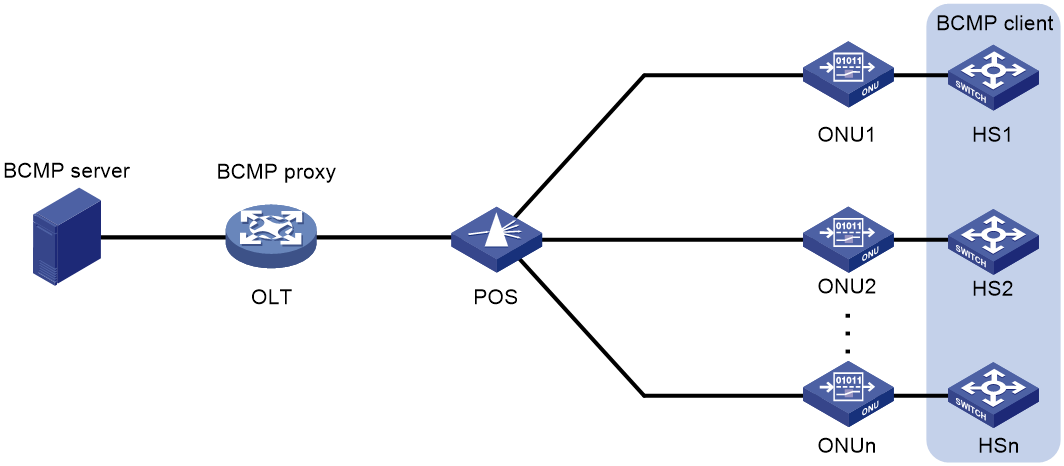- Table of Contents
- Related Documents
-
| Title | Size | Download |
|---|---|---|
| 06-EPON BCMP configuration | 73.21 KB |
Configuring EPON BCMP
BCMP overview
Broadband-access-network Cluster Management Protocol (BCMP) uses a BCMP server to centrally manage an EPON system as a management domain.
BCMP architecture
As shown in Figure 1, a BCMP system contains the following components:
· BCMP server—Master management server in a BCMP system. The BCMP server performs registration, configuration, management, and monitoring for members in the BCMP system.
· BCMP proxy—Proxy management server in a BCMP system. The BCMP proxy forwards member registration information and configuration between the BCMP server and BCMP clients.
· BCMP client—Member network elements in a BCMP system. BCMP clients are high-performance (HS) switches connected to ONUs or ONUs integrated with HS. The BCMP server centrally manages the BCMP clients through the BCMP proxy.
Figure 1 BCMP system architecture
Working mechanism
The BCMP server registers and configures a BCMP client by using the following Configuration procedure:
1. The BCMP client sends a registration request that contains its MAC address to the BCMP server.
2. The ONU connected to the BCMP client adds the UNI number of the client to the request, and forwards the request to the BCMP proxy (OLT).
3. The OLT performs the following operations:
a. Extracts the client MAC address and UNI number from the request.
b. Adds the ONU MAC address when re-encapsulating the request.
c. Sends the request to the BCMP server.
4. The BCMP server performs the following operations:
a. Extracts information from the request.
b. Creates a physical status entry for the BCMP client.
c. Sends the BCMP proxy the configuration for the client, including the management VLAN, management IP address, default gateway, and SNMP settings.
5. The BCMP proxy forwards the configuration to the BCMP client.
Restrictions and guidelines: EPON BCMP configuration
EPON features are supported only on the default MDC. For more information about MDCs, see Virtual Technologies Configuration Guide.
Configuring BCMP proxy
About BCMP proxy
You can configure an OLT as a BCMP proxy. For a BCMP proxy to communicate with a BCMP server, you must specify the IP address of the server on the BCMP proxy.
Configuration procedure
|
Step |
Command |
Remarks |
|
1. Enter system view. |
system-view |
N/A |
|
2. Enable the BCMP proxy feature. |
bcmp-proxy enable |
By default, the BCMP proxy feature is disabled. |
|
3. (Optional.) Specify the BCMP VLAN. |
bcmp-proxy vlan vlan-id |
By default, the BCMP VLAN is 4041. |
|
4. Specify the IP address of the BCMP server. |
bcmp-proxy server address ip-address |
By default, the IP address of the BCMP server is not specified. |
|
5. (Optional.) Specify the port number of the BCMP server. |
bcmp-proxy server port port-number |
By default, the port number of the BCMP server is 5000. |


